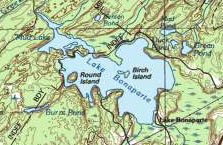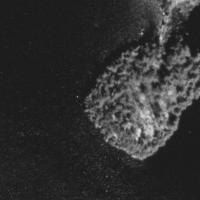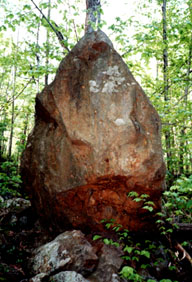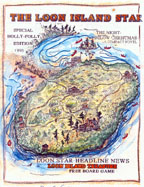

Sometime Island
What is that about?
Loon Island does appear in satelite photos, so the dissapearance obviously has something to do with the limitations of computer map making software, but the fact is that Loon Island will not always be there, has not always been there; and in the vague world of memory, Loon Island already seems to be drifting off in a mist.
But if I were to take my hands off this here keyboard, close my eyes, and make a loose fist with my right hand, I could still feel the stone which I found at age ten right in front of our Loon camp; and it it would still be warm:
Squatting in the sun on the door step that morning, I had been trying to carve a basswood stick with my cubscout knife, which had a blade better suited to spreading peanut butter. When the carving degenerated inevitablly into whitling, and the whitling came to nothing but shavings in front of the door step, I took to poking the knife blade into the packed dirt there. I hit something hard just below the surface , held in the crook of a varicose shadbush root. I then turned the knife to prying the object loose, breaking the tip off the knife as out popped this redish brown piece of flint: either a large arrow head or small spear point ; the like of which I had been hunting for half of my twelve years. It fit perfectly into my fist. Indian stone.
I held on to that stone for many years, then my sometime brother William borrowed it from my quiver, or I lost it somewhere between Ithaca and Lake Bonaparte.
That was the apex of my archeological career. I never found any other flint tools around the lake, or anywhere outside of curio shops. Until recently, I had never even noticed any flint in local rock.
Then one wet recent August in the Bonaparte Cave State Forest, as I walked along between the ridges scanning the ground before me to catch the appricot yellow glow that gives chantrell mushrooms away, I had a feeling I often have when they are near: as if had sensed their eyes on me. I looked up expecting to see a flush chantrells, but before me stood this ponderous boulder about sixteen feet high..
It would be notable just for its Budah nature, but beyond that, the stone was the very same shape and color as the lost Loon Island flint. What do I do with that? I can't pop it out and bring it home. It's a galcial eratic; it hasn't always been there and won't always be there, but for now it will stand and serve memory....
Foot notes:
Technically, since we stopped keeping the channel open under the board walk, what we call "Loon Island" is not technically an Island at all .
Also, siince Loon Island is private land, and could at some later time be sold out of the family, you should please, when the time comes, render me into potash and scatter my ashes around the Bonaparte Cave stone. But no plaques or inscriptions please, just remember:


